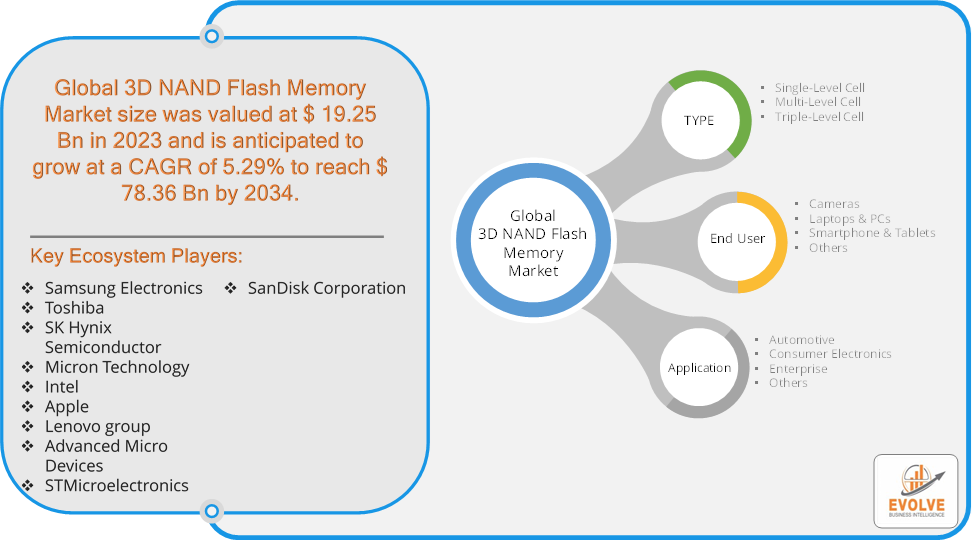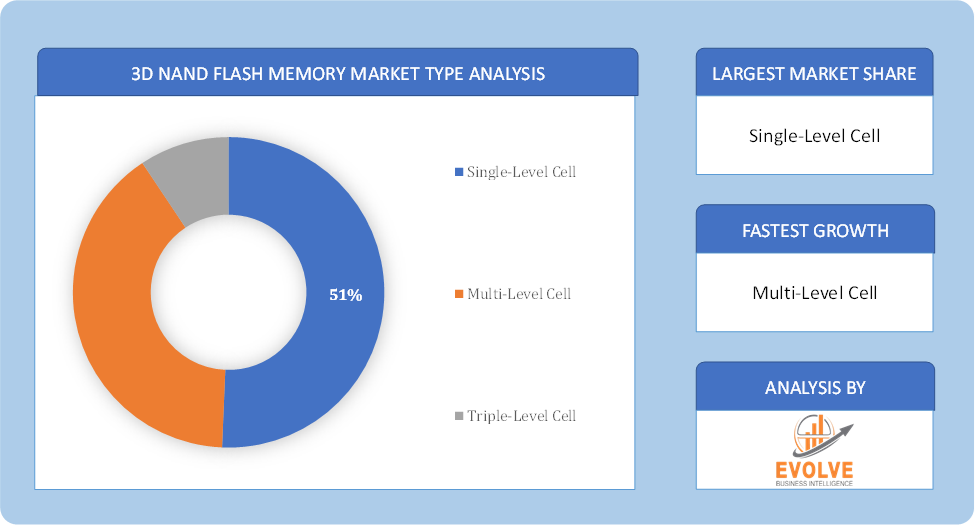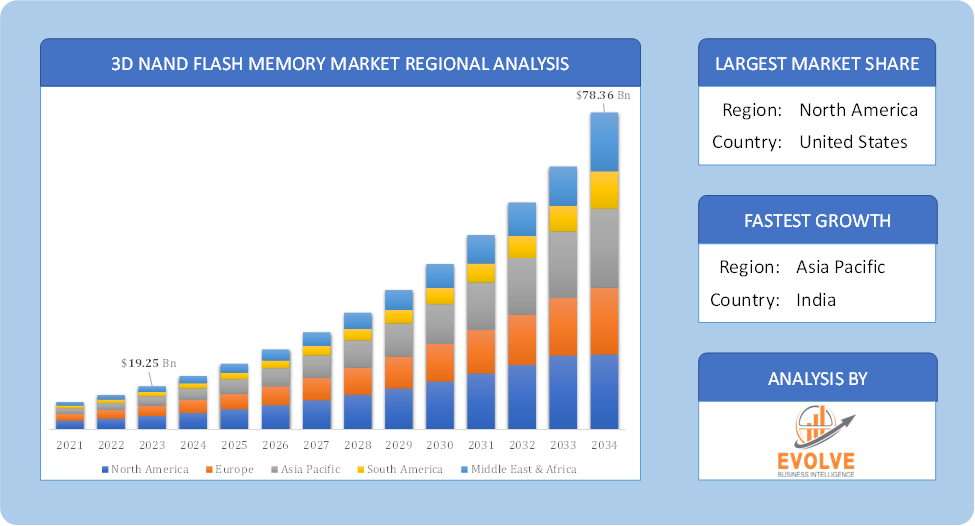3D NAND Flash Memory Market Overview
The 3D NAND Flash Memory Market size accounted for USD 19.25 Billion in 2023 and is estimated to account for 22.98 Billion in 2024. The Market is expected to reach USD 78.36 Billion by 2034 growing at a compound annual growth rate (CAGR) of 5.29% from 2024 to 2034. 3D NAND flash memory is a type of non-volatile memory that stores data in a three-dimensional structure, stacking memory cells vertically rather than horizontally like traditional 2D NAND. This design allows for greater storage density and improved performance compared to its predecessor.
The 3D NAND flash memory market is a rapidly growing industry that is driving advancements in data storage technology, enabling higher capacities, faster speeds, and improved reliability for a wide range of applications.
Global 3D NAND Flash Memory Market Synopsis
 3D NAND Flash Memory Market Dynamics
3D NAND Flash Memory Market Dynamics
The major factors that have impacted the growth of 3D NAND Flash Memory Market are as follows:
Drivers:
Ø Rising Adoption of SSDs
Solid-state drives (SSDs) using 3D NAND technology offer significantly faster read and write speeds compared to traditional hard disk drives (HDDs), leading to their increased adoption in personal computers, laptops, and enterprise servers. 3D NAND SSDs are more resistant to physical shocks and have a longer lifespan than HDDs, making them preferred for critical applications. Innovations in 3D NAND architecture, such as stacking memory cells in more layers (e.g., 96-layer or 128-layer), enable manufacturers to produce higher-capacity chips while improving performance. Technological advancements and manufacturing efficiencies help reduce costs, making 3D NAND flash more accessible and appealing to a broader range of consumers and businesses.
Restraint:
- Perception of High Manufacturing Costs and Technological Challenges
The production of 3D NAND flash memory involves advanced manufacturing techniques and technologies, which can be expensive. High capital investments in cleanroom facilities and specialized equipment can limit the ability of new entrants to compete. Continuous advancements in 3D NAND technology require significant R&D investments, which can strain financial resources, especially for smaller companies. While 3D NAND technology offers benefits, the complexity of scaling up production while maintaining quality can be challenging. Issues like yield rates (the percentage of usable products from a batch) can affect profitability.
Opportunity:
⮚ Data Center and Cloud Computing Growth
As businesses increasingly rely on cloud storage and computing, there is a substantial opportunity to provide high-performance 3D NAND SSDs for data centers that require speed, efficiency, and reliability. The growing focus on big data analytics requires robust storage solutions, creating demand for 3D NAND products that can handle large volumes of data efficiently. Developing environmentally friendly manufacturing processes and products can appeal to environmentally conscious consumers and businesses, creating market differentiation.
3D NAND Flash Memory Market Segment Overview
Based on Type, the market is segmented based on Single-Level Cell, Multi-Level Cell and Triple-Level Cell. The Triple-Level Cell segment dominant the market. TLC (Three-Level Cell) segment dominant the market. TLC flash includes solid-state drives (SSDs) for business and home use, storage cards for digital cameras and cell phones, and USB drives. Compared to SLC and MLC flash, which typically store two bits of data per cell, TLC memory offers a cheaper price per gigabyte (GB). NAND flash makers frequently use TLC with 3D NAND flash, in which the memory cells are stacked vertically on the chip.
By End User
Based on End User, the market segment has been divided into Automotive, Consumer Electronics, Enterprise and Others. The Consumer Electronics segment dominant the market. It is extensively employed in a wide range of consumer electronics devices including smartphones, tablets, and media players. Analysis of NAND flash memory market trends concludes that the increasing adoption of consumer electronics to provide non-volatile storage, high data transfer rates, and low power consumption is accelerating market expansion. Moreover, NAND flash offers improved speed and data processing capabilities including high-resolution images and high-capacity mobile games, further boosting the proliferation of the market.
By Application
Based on Application, the market segment has been divided into Cameras, Laptops & PCs, Smartphone & Tablets and Others. The Smartphone & Tablets segment dominant the market. A key component of smartphones today is flash memory storage. Due to the average capacity of smartphones, the need for NAND memory has been rising tremendously. In smartphones, NAND flash memory may significantly improve the speed of web browsing, email loading, gaming, and even social network sites. Manufacturers are incorporating technologies like gesture control, fingerprint scanners, and GPS. As a result, there is a greater need for NAND flash memory in smartphones.
Global 3D NAND Flash Memory Market Regional Analysis
Based on region, the global 3D NAND Flash Memory Market has been divided into North America, Europe, Asia-Pacific, the Middle East & Africa, and Latin America. North America is projected to dominate the use of the 3D NAND Flash Memory Market followed by the Asia-Pacific and Europe regions.
 3D NAND Flash Memory North America Market
3D NAND Flash Memory North America Market
North America holds a dominant position in the 3D NAND Flash Memory Market. The United States is home to several key players in the semiconductor industry, such as Micron Technology and Western Digital, contributing to a robust 3D NAND market and the increasing adoption of cloud services and the need for high-performance data centers drive demand for 3D NAND flash solutions. A strong market for high-end smartphones and laptops promotes the growth of 3D NAND applications in consumer electronics.
3D NAND Flash Memory Asia-Pacific Market
The Asia-Pacific region has indeed emerged as the fastest-growing market for the 3D NAND Flash Memory Market industry. The rapid expansion of the consumer electronics market, particularly in smartphones and tablets, is significantly boosting demand for 3D NAND flash memory and the increasing adoption of advanced driver-assistance systems (ADAS) and electric vehicles in countries like China further enhances market opportunities.
Competitive Landscape
The global 3D NAND Flash Memory Market is highly competitive, with numerous players offering a wide range of software solutions. The competitive landscape is characterized by the presence of established companies, as well as emerging startups and niche players. To increase their market position and attract a wide consumer base, the businesses are employing various strategies, such as product launches, and strategic alliances.
Prominent Players:
- Samsung Electronics
- Toshiba
- SK Hynix Semiconductor
- Micron Technology
- Intel
- Apple
- Lenovo group
- Advanced Micro Devices
- STMicroelectronics
- SanDisk Corporation
Scope of the Report
Global 3D NAND Flash Memory Market, by Type
- Single-Level Cell
- Multi-Level Cell
- Triple-Level Cell
Global 3D NAND Flash Memory Market, by End User
- Automotive
- Consumer Electronics
- Enterprise
- Others
Global 3D NAND Flash Memory Market, by Application
- Cameras
- Laptops & PCs
- Smartphone & Tablets
- Others
Global 3D NAND Flash Memory Market, by Region
- North America
- US
- Canada
- Mexico
- Europe
- UK
- Germany
- France
- Italy
- Spain
- Benelux
- Nordic
- Rest of Europe
- Asia Pacific
- China
- Japan
- South Korea
- Indonesia
- Austalia
- Malaysia
- India
- Rest of Asia Pacific
- South America
- Brazil
- Argentina
- Rest of South America
- Middle East & Africa
- Saudi Arabia
- UAE
- Egypt
- South Africa
- Rest of Middle East & Africa
| Parameters | Indicators |
|---|---|
| Market Size | 2034: USD 78.36 Billion |
| CAGR (2024-2034) | 5.29% |
| Base year | 2022 |
| Forecast Period | 2024-2034 |
| Historical Data | 2021 (2017 to 2020 On Demand) |
| Report Coverage | Revenue Forecast, Competitive Landscape, Growth Factors, and Trends |
| Key Segmentations | Type, End User, Application |
| Geographies Covered | North America, Europe, Asia-Pacific, South America, Middle East, Africa |
| Key Vendors | Samsung Electronics, Toshiba, SK Hynix Semiconductor, Micron Technology, Intel, Apple, Lenovo group, Advanced Micro Devices, STMicroelectronics and SanDisk Corporation |
| Key Market Opportunities | · Data Center and Cloud Computing Growth · Green Technology Initiatives |
| Key Market Drivers | · Rising Adoption of SSDs · Advancements in 3D NAND Technology |
REPORT CONTENT BRIEF:
- High-level analysis of the current and future 3D NAND Flash Memory Market trends and opportunities
- Detailed analysis of current market drivers, restraining factors, and opportunities in the future
- 3D NAND Flash Memory Market historical market size for the year 2021, and forecast from 2023 to 2033
- 3D NAND Flash Memory Market share analysis at each product level
- Competitor analysis with detailed insight into its product segment, Government & Defense strength, and strategies adopted.
- Identifies key strategies adopted including product launches and developments, mergers and acquisitions, joint ventures, collaborations, and partnerships as well as funding taken and investment done, among others.
- To identify and understand the various factors involved in the global 3D NAND Flash Memory Market affected by the pandemic
- To provide a detailed insight into the major companies operating in the market. The profiling will include the Government & Defense health of the company’s past 2-3 years with segmental and regional revenue breakup, product offering, recent developments, SWOT analysis, and key strategies.









